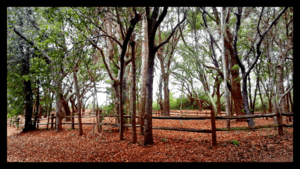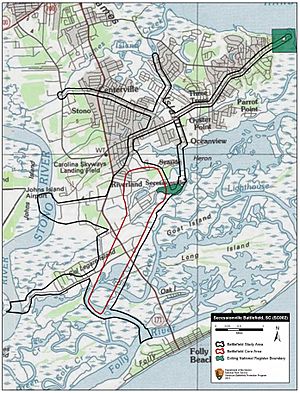Battle of Secessionville facts for kids
Quick facts for kids Battle of Secessionville |
|||||||
|---|---|---|---|---|---|---|---|
| Part of the American Civil War | |||||||
 Secessionville Battlefield |
|||||||
|
|||||||
| Belligerents | |||||||
| Commanders and leaders | |||||||
| Henry Benham | Nathan G. Evans Thomas G. Lamar States Rights Gist |
||||||
| Units involved | |||||||
| North District, Department of the South | 2nd Military District of South Carolina Tower Battery/Fort Lamar Garrison |
||||||
| Strength | |||||||
| 6,600 | 2,000 | ||||||
| Casualties and losses | |||||||
| 685 | 204 | ||||||
The Battle of Secessionville, also known as the First Battle of James Island, happened on June 16, 1862. It was a key battle during the American Civil War. In this battle, the Confederate army stopped the Union from capturing Charleston, South Carolina, by land. Union General Henry Washington Benham was later put on trial for attacking James Island. This attack went against the orders he had been given.
Why the Battle Happened
Charleston was a very important city for the Confederacy. It was one of their main ways to get supplies from other countries. General Robert E. Lee said that losing Charleston would cut them off from the rest of the world.
After another battle, the Union army decided to try and capture Charleston. They took over Edisto and John's Island. By early June 1862, many Union ships were in the Stono Inlet. Union troops then moved to James Island. They landed at a place called the Thomas Grimball plantation.
The Confederate army had built strong defenses on James Island. These defenses included a wall of earth called a breastwork. This wall was about 125 yards wide. It separated Folly Island from Morris Island. This defense was known as the Tower Battery. It had a tall platform for looking out over the area.
Captain Thomas G. Lamar was in charge of the Tower Battery. General States Rights Gist was in charge of all defenses on James Island. The battery had powerful cannons and about 500 soldiers. Secessionville itself was just a small group of summer homes.
The defenses on James Island stretched from Fort Pemberton in the west to the Tower Battery. They then went up to Fort Johnson in the east. Many Confederate units were there. These included soldiers from South Carolina and Louisiana.
The Battle Begins
In early June 1862, Union General David Hunter sent his troops to James Island. General Henry Washington Benham led about 6,600 Union soldiers. They set up camp at Grimball's Landing. This was close to the Confederate defenses. The Union soldiers came from states like New Hampshire, Michigan, Connecticut, Massachusetts, Pennsylvania, New York, and Rhode Island. They planned to march towards Charleston.
On June 10, Confederate General John C. Pemberton sent troops to Grimball's plantation. They wanted to set up their own cannons against the Union ships. But Union soldiers fought back strongly. The Confederates had to retreat.
On June 14, General Nathan George Evans arrived and took command of the Confederate forces. For the next two days, both sides fired their cannons at each other. More Confederate soldiers joined the Tower Battery.
Around 4:30 AM on June 16, the Union army attacked the Confederate fort at Secessionville. Colonel Thomas G. Lamar commanded about 500 Confederate soldiers there. They had many heavy cannons. The land around the fort was marshy, which made it hard for the Union to attack.
The 8th Michigan regiment led the Union attack. The 7th Connecticut and 28th Massachusetts followed them. The Confederate cannons fired "grape and canister" shot. This was like a giant shotgun blast. It caused many Union soldiers to fall. Some Union soldiers still managed to reach the fort. They fought hand-to-hand with the Confederate artillerymen.
Soon, Confederate soldiers arrived to help Lamar's men. These included the 9th South Carolina Battalion and the Charleston Battalion. The battle turned into a fierce rifle fight along the fort's wall. The 7th Connecticut and 28th Massachusetts got stuck in the marshy mud. They were mixed together and under heavy fire. More Confederate troops arrived to reinforce the fort.
A Union cannon battery finally began firing at the fort. The 79th New York "Highlanders" then advanced. But Confederate fire pushed them to the right side of the fort. They joined the remaining 8th Michigan soldiers. The 79th tried to climb over the fort's wall. But they were forced back, just like the 8th Michigan before them. Union reinforcements did not arrive in time.
The 100th Pennsylvania tried to support the Highlanders. But their attack also failed due to the Confederate cannons. The 46th New York tried to join the fight. But some of their soldiers retreated with others. The rest faced more cannon fire. Finally, the Union general ordered a full retreat. The attack had lasted less than 45 minutes.
But the Union attacks were not completely over. On the other side of the marsh, the 3rd New Hampshire tried to attack the fort's right side. But 150 yards of marsh stopped them. Confederate cannons fired at them from behind. The 4th Louisiana and other Confederate units moved to defend the fort. The 3rd New Hampshire found themselves surrounded by fire. They were forced to retreat.
After the Battle
Colonel Thomas Lamar was called "The Hero of Secessionville" for his defense. General Benham called the battle a "reconnaissance in force." This meant he claimed it was just a strong scouting mission.
General Hunter removed Benham from his command. He said Benham had disobeyed orders by attacking Charleston. Benham was put under arrest. By July 7, all Union forces had left James Island.
Later, in January 1863, a military judge decided that Benham's attack was allowed. It was not against the orders he had been given. However, Benham was never given command of troops in the field again.




